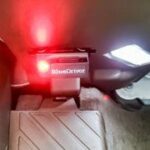Like many car enthusiasts, I’ve always been fascinated by the untapped potential lurking within our vehicles. It’s like knowing your car could be performing better, smoother, and more efficiently, if only you could unlock its hidden reserves. This curiosity led me down the path of ECU remapping, and like many beginners, I started exploring how tools like an OBD2 scanner could play a role. In my journey, the Altec OBD2 scanner became a key companion, offering insights I never thought possible.
For those new to the automotive world, the Engine Control Unit (ECU) is essentially your car’s brain. It manages a multitude of engine functions, from fuel injection and ignition timing to emissions control. Manufacturers program these ECUs with settings designed for a broad range of driving conditions and driver preferences, often prioritizing factors like longevity and emissions over peak performance. ECU remapping, also known as ECU tuning or chipping, involves modifying this factory software to optimize engine performance, fuel efficiency, or both.
Now, where does an OBD2 scanner, specifically an Altec OBD2 scanner, fit into this picture? It’s crucial to understand that an OBD2 scanner doesn’t directly perform the ECU remapping itself. Remapping is a more complex process often involving specialized software and interfaces to rewrite the ECU’s program. However, an OBD2 scanner is an invaluable tool before, during, and after the remapping process.
Firstly, before even considering an ECU remap, an OBD2 scanner like the Altec can help you assess your car’s health. Think of it as a pre-tuning check-up. By connecting the scanner to your car’s OBD2 port (usually located under the dashboard), you can read diagnostic trouble codes (DTCs), check live engine data, and evaluate various system parameters.
For example, the “Miles Since Code Clear” reading, which I learned about through my Altec scanner, can be incredibly revealing. A suspiciously low number might suggest that someone has recently cleared fault codes without actually addressing the underlying issues. Similarly, monitoring “Long Term Fuel Trim” can indicate if your engine is running too lean or too rich, potentially highlighting problems that should be resolved before any tuning modifications. Ideally, fuel trim values should be within a reasonable range, typically less than +/- 10% during normal driving. High values might point towards vacuum leaks, fuel delivery issues, or sensor malfunctions.
Another critical parameter to monitor with your Altec OBD2 scanner is “Knock Retard.” Engine knock, or detonation, is a damaging phenomenon that occurs when the air-fuel mixture in the cylinder ignites in an uncontrolled manner. The ECU uses a knock sensor to detect this and retards the ignition timing to protect the engine. While some occasional knock retard under heavy load might be normal, consistent knock, especially with the recommended fuel octane, is a red flag. Before remapping, ensuring your engine is free from excessive knock is essential.
Furthermore, checking for “Pending DTC’s” with your Altec scanner is vital. These are codes that haven’t yet triggered the check engine light but are stored in the ECU’s memory. They can be early indicators of potential problems that could be exacerbated by ECU remapping. Addressing these pending issues beforehand ensures a smoother and safer tuning process. You can also use the scanner to check for “Misfires,” which are incomplete combustion events in the cylinders. While occasional misfires might be normal, a significant number, especially in a specific cylinder, can indicate problems with spark plugs, ignition coils, fuel injectors, or compression.
After the ECU remapping is performed by a professional tuner or through a reputable DIY method, your Altec OBD2 scanner becomes even more valuable. It allows you to monitor the effects of the remap in real-time. You can observe how parameters like fuel trim, boost pressure (if applicable to your car), air-fuel ratio, and engine temperature are behaving under different driving conditions. This post-remap monitoring is crucial to ensure the tune is running safely and effectively, and to identify any potential issues that may arise.
In conclusion, while an Altec OBD2 scanner isn’t the tool to directly remap your ECU, it’s an indispensable asset for anyone considering or having undergone ECU tuning. It provides critical insights into your engine’s health before modifications, and allows for continuous monitoring of the remap’s impact afterwards. Whether you’re aiming for increased horsepower, improved fuel economy, or a more responsive driving experience, understanding how to use an OBD2 scanner in conjunction with ECU remapping is key to unlocking your car’s true potential safely and effectively.
